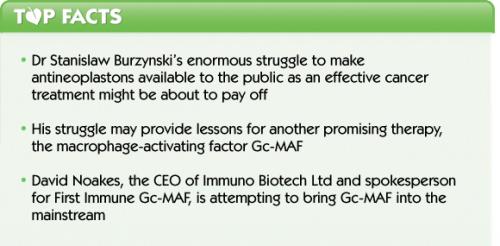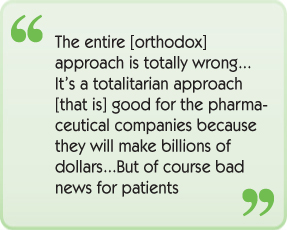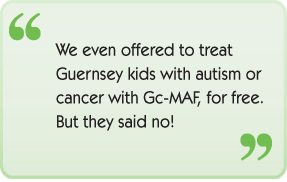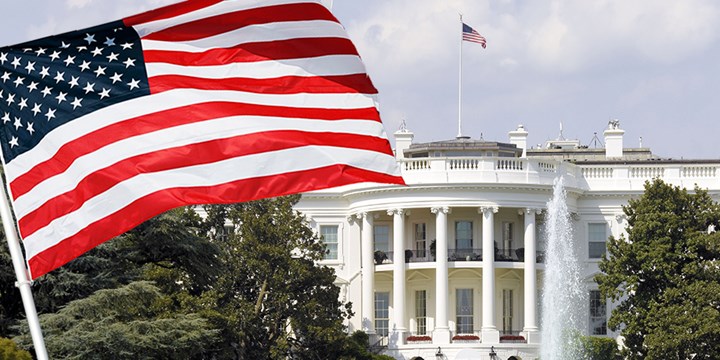Content Sections
Mainstream medicine plays very dirty indeed to defend its near-monopoly on cancer treatment, leaving a long trail of promising cancer treatments lying ignored and suppressed in its wake. By way of illustration, Dr Stanislaw Burzynski may be on the verge of a hard-fought breakthrough for his antineoplaston treatment – and his struggles offer an object lesson about the trials in store for another promising therapy, Gc-MAF.

The high-profile Dr B
You may have heard of Dr Stanislaw Burzynski, the discoverer of antineoplastons. Not only has his work received considerable media and blogosphere attention, both favourable and hostile, but he’s already been the topic of one documentary with a sequel in the works. There is a reason for his visibility: unlike so many cancer researchers who choose to operate outside the mainstream model of ‘cut, poison, drug and burn’, Dr Burzynski has stood firm against everything that has been thrown at him. What’s more, he appears to be winning.
What are antineoplastons?
In short, they are protein components, known as peptides, that Dr Burzynski believes have a twofold role in cancer prevention. In his own words, “The human body has...molecular switches, some of which turn off oncogenes, and others which turn on tumor-suppressor genes. These switches are called antineoplastons, which are naturally occurring peptides and amino acid derivatives in the blood and urine that the human body naturally uses to control cancer growth...The name “antineoplastons” comes from their function in controlling neoplastic or cancerous cells: i.e., anti-neoplastic cell agents.”
Antineoplaston landmarks
Dr Burzynski’s story is long, involved – and breathtaking. In short, it’s a tale of dogged determination by one man to bring a highly promising cancer treatment to market, in the face of a US government campaign of intimidation, harassment, sabotage and attempted patent theft. To simplify things, we’ve put together a list of major events in Dr Burzynski’s struggle to bring antineoplastons to public attention and availability, which you can download here.
Burzynski on Burzynski
This stunning story is best summed up by a quote from Dr Burzynski himself: “The entire [orthodox] approach is totally wrong. It’s based on the microscopic diagnosis of cancer which is about one hundred and sixty years old. Without really looking at what is causing cancer, without looking for the genetic signature of the cancer...[it’s a] terrible waste, waste of resources, a terrible waste of human lives because in the meantime these patients obviously will not respond and they could respond if they would be given good medicine...It’s a totalitarian approach [that is] good for the pharmaceutical companies because they will make billions of dollars...But of course bad news for patients.”

Gc-MAF: antineoplastons mark II?
Back in 1993, Nobuto Yamamoto, then working at Temple University School of Medicine in Philadelphia, PA, USA, first described a remarkable molecule. His paper reported the conversion of vitamin D3 binding protein (DBP, known in humans as Gc) into a potent macrophage-activating factor (MAF), known as Gc-MAF. Macrophages are a key part of the human immune system with two roles: to engulf and destroy pathogens and cellular debris, and to recruit other immune cells to respond to the pathogen.
Macrophages are crucial to both innate, or non-specific, immunity and adaptive, or specific, immunity. Under normal circumstances, Gc-MAF is upregulated when the immune system detects a threat, ‘activating’ macrophages so that they single-mindedly pursue pathogens. Cancer cells, a prime target of macrophages, are clever little critters that secrete an enzyme – alpha-N-acetylgalactosaminidase or nagalase – that inactivates Gc-MAF, thus preventing macrophages from becoming activated and protecting cancer cells. Administration of Gc-MAF is proposed to bypass nagalase, stimulating macrophages to become activated and attack tumour cells. In other words, it’s a potent immunomodulator, rather like antineoplastons.
So why haven’t most of us heard of it?
Unlike antineoplastons, however, Gc-MAF hasn’t had the benefit of a single patent owner – as a natural molecule, it cannot be patented without being modified – with the will and resources to push it under the noses of the public and health authorities. Dr Yamamoto has run small human trials in breast, prostate and colorectal cancers, with promising results. However, he is by no means alone, as David Noakes is at pains to point out: “There’s better research than Dr Yamamoto’s out there these days, and it’s all listed on our website,” he says.
David Noakes might just be the person to bring Gc-MAF into the mainstream. He’s the CEO of Immuno Biotech Ltd. and spokesperson for First Immune Gc-MAF, a project he describes as, “PhD and BSc biochemists and biomedical scientists...with external doctors, oncologists and scientists who kindly provide advice, committed to bringing some of the increasing number of published but relatively unused medical cures to as many people as we can.” At the moment, Noakes and his colleagues are supplying Gc-MAF to 30 countries where it is legal, via a network of “around 300” doctors. Their Gc-MAF is made to extremely high standards, and is being used in ongoing clinical research by Noakes’ collaborators and others. Their ultimate goal is to, “Build the case that GcMAF is effective for various illnesses, which will help to make it available to the public”.

An uphill struggle
Noakes has no illusions about the struggle he faces, as he explained to ANH-Intl. “Doctors, cancer doctors especially, know what they’re up against in countries like the US and UK. In all of the US, there’s only one doctor – Jeffrey Bradstreet, MD – who’s so far been prepared to put his head above the parapet about Gc-MAF. Many more take a cautious but pragmatic attitude; they might say to their patients, “Get it, but please don’t tell me!””
Getting nowhere in Guernsey
Recently, Noakes asked the Guernsey authorities whether they would allow First Immune Gc-MAF to produce the product in peace, in their own laboratory, hoping to take advantage of the island’s historically liberal attitude and exemption from EU laws. “We even offered to treat Guernsey kids with autism or cancer with Gc-MAF, for free – and anyone with infectious diseases for one-third of the normal cost. But they said no!” he reports in disgust. “Guernsey has even declared Gc-MAF an illegal drug, unlike anywhere else in the world. It’s come to something when Dubai is a better environment for the production and distribution of a potentially life-saving treatment than Guernsey, the UK or USA, but there you go.”
In a topsy-turvy world, there’s nothing more upside-down than cancer research, as these two stories powerfully confirm. But everyone should be encouraged that Dr Burzynski appears on the verge of bucking the US system. We wish Dr Burzynski, David Noakes and his collaborators all the luck in bringing their potentially game-changing treatments into the mainstream, and into the hands of as many cancer patients as possible.








Comments
your voice counts
30 January 2013 at 9:13 pm
Speaking as someone declared terminally ill in January 1999 and alive thanks to skilled homoepathic treatment, Tibetan medicine and the daily practice of Guo Lin Cancer Control Qigong, I can't help but observe that this is an extremely old story.
So many promising therapies have been undermined and so many promising careers have been destroyed. I think it was Ralph Moss who observed, possibly about Dr Burzynski, that one might expect that anyone developing a promising cancer treatment might expect statues to be erected in every city.
As of yet, no statue exists, but Dr Burzynski is a brave and a determined man who has done remarkably well up to now.
I wish him luck.
31 January 2013 at 3:20 am
To paraphrase the skeptic jibe:
- What do you call alternative medicine that works?
- "Banned" medicine.
31 January 2013 at 11:36 pm
Yes, as Kevin has mentioned above, Dr Burzynski is one of those brave individuals who deserves to be celebrated as a hero in the medical field, and one who may be close to being able to claim, that he has in fact found a cure for many cancers.
In truth, cancer seems to be an highly treatable condition, but the best and most health-supporting, intelligent treatments aren't available on the NHS or even in private institutional care. And clearly, with the intimidation and persecution that many non-pharma therapies and treatments face,this isn't just from being out of date. Sick people make good business for pharmaceutical companies, and in a moment in history where multi-national corporations rule the world, with governments at their beck and call, it's hardly surprising that treatments that actually make people well and cannot be turned into a cash-cow, are being blocked at every turn. The resistance his work is meeting is probably representative of the threat Dr Burzynski's treatment poses to the 'sickness industry', and I've no doubt that history will look back on him with great gratitude for his determination , compassion and belief in his aims.
I also, wish him great luck!
02 February 2013 at 4:52 am
Thank you Dr Burzynski for your persistence, courage and so much effort. I'll not forget Dr Robert Rife's story either. My husband was diagnosed with terminal cancer in 2009 and chose the medical system of clinical trial injection of radiation balls into his liver to treat colorectal cancer and this was partnered with chemo. We were "alternative" people who had utilised supplements for 30 years so tried Vitamin C injections, and when the Ascetes? was so bad tried some infusions of curcumin (tumeric), green tea and one other which escapes my memory until the liver results were so bad. As I am a practitioner of many "energy" modalities we also incorporated these and also from supportive friends until he died 16 months later basically due to liver failure. If I am ever faced with cancer until that time I won't know what my choice will be but I do feel at this time it will be alternative. Thank you again Dr Burzynski for all you do.
11 February 2013 at 10:01 pm
As Phillip Day says, "There's no money in health!"
14 February 2013 at 7:04 am
There are herbal and nutritional medicines which switch on tumour suppressor genes and turn off oncogenes. The injection of peptides, presumably obtained from so-called lab animals, is neither an ethical nor a natural form of medicine.
This approach, though admittedly less harmful and less toxic than the usual chemo / radiation treatments, nonetheless still adheres to the classic orthodox reductionist approach to medicine.
This is not to say that Dr B's ostracisation isn't a crying shame....
21 March 2013 at 1:15 pm
Hi Gabriela, Dr Burzynksi first identified antineoplastons in human urine, and now manufactures them in a laboratory. As far as we know, they are not obtained from lab animals. Whilst we agree on the animal testing front, we're also open to treatments that promise to be safe and effective even if they are obtained through a reductionist approach.
01 November 2013 at 9:33 pm
Drug companies look for "TREATMENTS" not CURES AT £20,000 per patient per year it's more profitable.
Take a look at this.A Canadian man came up with this CURE and he has been hounded by on and all I would think at the say so of drug companies .
http://www.trueactivist.com/gab_gallery/cannabis-helps-3-year-old-beat-cancer-better-than-chemo/.
18 November 2013 at 1:15 pm
I was trying to read up about this company. Immuno Biotech Ltd is not registered at Companies House. The links to the website are no longer valid. First Immune Ltd is registered but as a specialist food company in Bournemouth, so I wonder if this is the same company? Are you sure this is not a scam? I fully appreciate Dr Burzynski's stance, but am wondering if this is not another here today, gone tomorrow type of scam. I am finding a David Noakes, as a fail contender for the leadership of the UKIP party, as well as the CEO of this non-existant company. More research has him described by an ex colleague on his exit from the UKIP party:
Mark Croucher, a senior activist and former Ukip director of communications, described Mr Noakes as "a swivel-eyed loon whose insane conspiracy theories make the rest of us look as mad as a box of frogs... so good riddance. He should really be locked up in a secure unit."
Lets hope this is not a maverick treatment by a snake oil salesman
18 November 2013 at 5:40 pm
Hi Anonymous, thanks for getting in touch. Since we wrote that article in January, it does appear that the Immuno Biotech Ltd. and FirstImmune websites have been redesigned, with the result that many of the links no longer work. Immuno Biotech is registered in Guernsey, not the UK, hence why it’s not listed at Companies House: http://www.guernseychamber.com/index.php?moreinfo=731. The FirstImmune website is very much active: http://www.gcmaf.eu/. We’re sure you could find similar information to that contained in our article if you spent a bit of time searching through the website. We suspect that FirstImmune is registered in Belgium, since the website displays a Belgium address.
Frankly, we don’t believe that Mr Noakes’ political leanings or background are relevant here. You appear keen to discredit the work of the biomedical company because it is headed by Mr Noakes. It’s a pity you seem less interested in the evidence and potential for GcMAF revealed by Mr Noakes’ scientific colleagues and others.
18 January 2014 at 4:05 pm
It is a scam. If there were any scientific validity in GC MAF - a substance which its advocates claim as a universal panacea for anything from AIDS to schizophrenia - mainstream drug companies would be all over it like the measles.
25 April 2014 at 12:00 am
Shows how corrupt country's are now that they are shown the way by pharmaceutical companies, they should embrace the new advanced technology's not suppress them for the sake of money
25 August 2014 at 10:20 pm
I reside in Canada British Columbia, and would like to know how I can get access to this type of treatment MAF antineoplastons mark II there are so many people I know who have various types of Cancer and who I know would love to know and receive this treatment. I myself am a cancer survivor of 20 yrs, mo thanks to the radiation which I reluctantly received, and now have to deal with the ongoing damage from the radiation.
anxiously awaiting your reply
Sincerely Chandra
30 January 2015 at 11:21 am
Hi Chandra. Please accept our apologies for the delay in responding. We presume you are referring to Gc_MAF? If so please contact https://www.gcmaf.eu
29 July 2015 at 2:01 am
Dr. Jeffrey Bradstreet (the MD whom Noakes praised for the being the only Dr in the US to be working for GcMAF use) has recently been murdered -- just 2 weeks after the US Food & Drug Administration raided his offices looking for GcMAF. He was found floating in a river with a bullet hole in his chest.
30 July 2015 at 4:55 am
Why has cancer treatment got to be so complex, and why do we need patents for anti-cancer medicines? We already have macrophage and natural killer cell activating herbal medicines, such as Echinacea, Cat's claw, Saw palmetto, etc. and various medicinal mushrooms. Moreover, various nutrients, such as zinc, appear to play a macrophage activating role, since deficiency reduces macrophage activity against pathogens.
02 March 2017 at 10:20 pm
I am a terminal cancer patient and a medical cancer patient. I have High-grade serous cell ovarian carcinoma
as I am a BRCA1+ (like Angelina Jolie). My sister died from the same cancer I was diagnosed with 90 days after
her death. She died from the chemo, not the cancer. There are NO KNOWN SURVIVORS of my cancer when it
recurs as peritoneal carcinomatosis. NONE.
I refused chemo every time they offered it as it can't help me according to all the medical articles I read.
When High-grade serous carcinoma of the ovaries recurs, it is called peritoneal carcinomatosis, long words that
mean "TERMINAL" in the English that ordinary people without God complexes use. So, I am terminal
according to all of my doctors. First Immune is a biotech company that sells GcMAF which uses your
body's immune system to kill the cancer. I have a highly aggressive cancer. It is the most virulent,
most malignant and most deadly of all the gynecological cancers, discovered during a preventative
hysterectomy--to PREVENT the cancer it revealed.
The cancer I have DOUBLES in size every 5-6 weeks. I have been following First Immune's stage 4 cancer
protocol to the LETTER with the GcMAF injections and dietary and vitamin protocols. I've had ZERO side
effects--NONE!! I also have a November 2016 MRI that shows that my larger tumor has NOT progressed AND
the smaller one has shrunk by almost 3/4 of a centimeter and the scattered miliary tumors are gone. This
cancer NEVER SHRINKS. NEVER. It is 100% fatal and is considered an incurable cancer--that the oncologists
wanted to treat with a 40 year old protocol. I am writing a book about this experience and it has been a real
eye-opener about the total corruption of the FDA which is owned and run by Big Pharma.
I have MRIs that PROVE GcMAF works, and that I am ALIVE makes me LIVING proof it works.
I owe my life to First Immune's GcMAF, I have no doubt of that. I am not 100% cured yet, but I am
confident I would have been when I finish the treatment. It takes 6-18 months depending on your
cancer type,and it may take me another year to beat this--however, it's not like I'm being poisoned
by chemo, bald, vomiting and eaten down to the bone. You would never know I have cancer by looking
at me. I look healthy and feel fine. If GcMAF cures HGSC peritoneal carcinoma, in my opinion it will cure ANY cancer.
Researchers testing GcMAF stated it, "works 100% of the time to eradicate cancer completely, and cancer does
not recur even years later." The weekly injection GcMAF, a harmless glyco-protein activates the human immune
system which then can kill the growing cancer. Studies among breast cancer and colon cancer patients produced
complete remissions lasting 4 and 7 years respectively. This glyco-protein cure is totally without side effects but
currently goes unused and completely ignored by cancer doctors. Why? Maybe it is because there is little money
to be made in selling it. For less than $20,000 US Dollars a cancer patient can obtain an adequate amount of
GcMAF to cure most cancers. In the USA, Chemo is 3/4 of a million dollars for a round--big moneymaker for them!
I have an incurable cancer. I had been given 6 months to live in July of 2016 and told I would die around November 2016.
It's March 2017 as I am typing this and I am NOT PRESENTING ANY SYMPTOMS OF CANCER. I feel fine, plenty
of energy and I DO NOT have so much as a swollen lymph node anywhere. No ascites, no pain, NO NOTHING. I am
totally asymptomatic and my doctors are BAFFLED. They don't know I am going after my own cure since chemotherapy
has zero chance of curing me. Cancer is an immunodeficiency disease and chemo kills the cancer cells but destroys the
ALREADY COMPROMISED immune system so when it comes BACK the body has no way to fight it off.
I OWE MY LIFE TO DAVID NOAKES AND FIRST IMMUNE. I have attached the MRI reports--documented legal medical
records that PROVE that GcMAF works. However, I have not completed my cure, and now I will very likely DIE because
of this smear campaign by Big Pharma or whatever the UK version is of Big Pharma. I will be coming to England to testify
in behalf of David Noakes. He is a visionary and a hero and has cured thousands of people with his immunotherapy drugs
and I am going to reach out to all of them and should this proceed to a trial, you can expect thousands of sworn affidavits
from grateful patients. I'm probably going to die because of what the handmaidens of Big Pharma have done to David
Noakes--but I will die praising him for giving me at least an extra year of high-quality life because of GcMAF. He is a medical
hero and my doctor here in the USA (I am in the United States) is also sending an affidavit that GcMAF works. She wasn't
a believer at first but she can't argue with my tumors disappearing and my cancer symptoms resolving. Big Pharma with this
smear and raid has signed my death warrant--but I will die cursing them and trying to help David Noakes continue to bring
his CURE--NOT A REMISSION--A CURE for cancer AND MANY OTHER THINGS to suffering and dying people.
My medical records will document that I have an unsurvivable cancer that never shrinks--yet with First Immune's GcMAF they
were shrinking and disappearing. I would have become the first known survivor of a terrible cancer that kills everyone and
now I am going to die because of Big Pharma--but I will not be silent and I am NOT dead yet. I've never had chemo. Documented.
I was told I'd die in November 2016. 6 months later I'm still here with an MRI coming up this week that I am sure will show
continued progress. I am hoping that the supply of GcMAF I have in my freezer will be enough to complete my cure, but I
am certain that I would have died--just like my sister did--had I allowed Big Pharma's doctors to poison me with chemo.
Google me. I am a real person. I'm going to take the witness stand to defend David Noakes and First Immune too if I am alive, and
I will video my testimony if losing access to the CURE takes my life, to help others. This is WRONG, it's a smear and if you want
the story of the century on medicine, research what I have written--it's ALL true. I'm not sure the media these days cares about the
truth any more, but on the small chance you do, here is your opportunity to do the right thing AND win journalism awards for
the story. I am at your disposal for comments either through email, Skype or any other communication method.
The MRI I will send via pdf file shows my cancer progress from no cancer after the surgery to the recurrence in July, and progression in August to the shrinkage and disappearance in November 2016 and I'm having another one this Friday March 3rd 2017 and I will send the results (that I am certain will show continued progress) to anyone who would like to see them as soon as I have them.
Dr. David Noakes is a hero and I owe him my life. I will NOT be silent. I did this--and bet my life of GcMAF and it's the only reason
I am not dead. Contact me. I'm REAL and I am telling the truth. Do the right thing and print some truth.
[email protected]
Your voice counts
We welcome your comments and are very interested in your point of view, but we ask that you keep them relevant to the article, that they be civil and without commercial links. All comments are moderated prior to being published. We reserve the right to edit or not publish comments that we consider abusive or offensive.
There is extra content here from a third party provider. You will be unable to see this content unless you agree to allow Content Cookies. Cookie Preferences